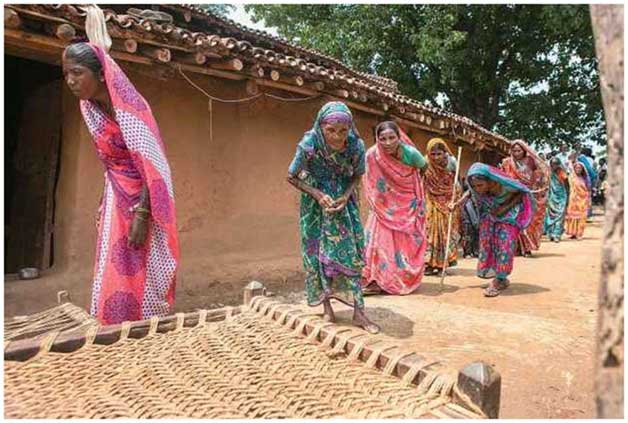
Prime Minister Narendra Modi in Varanasi faces a host of candidates who are contesting to focus on issues neglected by the governments, both at the Centre and in states. Some are contesting also from Rae Bareli, from where Congress President Rahul Gandhi is going to contest. Varanasi goes to polls on May 19, and Rae Bareli on May 6. Congress and other parties who ruled for decades at Centre and in states including UP failed to tackle basic problems of people. The BJP and its NDA allies, ruling vast parts of India and for several terms, proved no different despite great slogans. Modi-led rule is shown as a panacea. The contestants want to convey the message that the self-proclaimed kaamdar (efficient ) PM is after all no better than others in many respects when it comes to tackling basic problems of people, including bare minimum needs like safe drinking water. Hence the symbolic contest in Varanasi by so many candidates.
Swach Bharat Mission (SBM) is impossible without Swach Jal. Sab ka Vikas is not possible without safe drinking water to all, and when farmers constituting 70 percent population are neglected. Make in India is impossible when crores of people, more so the toiling classes, are down with diseases and are crippled. But all these slogans are peddled, and relayed without much questioning , by mainstream media. In this context, the contest in Varanasi by more than hundred activists to focus attention on burning problems of people is significant.
They are not impressed by BJP’s talk on Pulwama, and instead question Narendra Modi in Varanasi about his failures to address very basic but grave problems people all over the country are facing.
A Report by PTI from Varanasipublished on April 13, 2019 said :
A group of 111 farmers from Tamil Naduand fluorosis victim Ansala Swamy are also among those set to take on Modi in Varanasi. The group, comprising 111 farmers, is led by P. Ayyakannu. And they had staged protests in Delhi in 2017.
There are others, too, like the victims of fluorosis from Nalgonda (Telangana) and Prakasam (Andhra Pradesh), led by activists Vadde Srinivas and Jalagam Sudheer. Fluoride contamination of groundwater is a serious issue in the two states and their aim is to talk about it from a place that will be in focus.
As reported by countercurrents.org on April 6, 2019 :
Nizamabad Loksabha Constituency of Telangana had 185 candidates, including over 170 farmers, in the Phase-1 of current elections held on April 11, 2019. Mostly turmeric producers, they made big news by their novel protest: The farmers had chosen to contest the elections, as Independents, to protest the governments’ failure to ensure remunerative prices for turmeric and red jowar (sorghum) produce and establishing the turmeric board. Both the Centre and the State are responsible for this. Turmeric rates in wholesale market have fallen Rs 4,000-5,000 per quintal this year in comparison to Rs 12,000 per quintal in 2014, reported PTI (April 04, 2019, Economic Times).
This form of protest was tried earlier by Fluorosis victims in Telangana, to draw attention to their problems neglected by governments.
In the 1996 Lok Sabha elections in Nalgonda constituency, it may be recalled, a record number of 480 candidates filed their nominations to protest the lack of safe drinking water for the fluoride-affected villages of the district. It was part of a mass movement that ultimately forced governments to take up several measures to counter fluorosis. Though fluorosis is there all over India, it was only in Telangana that substantial measures were taken as a result of a mass movement that acquired a political momentum in course of time.
Fluorosis : A water-related disease threatening 10 crore Indians
In UP high fluoride problem was there in 18 dts. A Unicef report (cited by Times of India, January 2, 2004) said that 11.77 million people in the state were supposed to be having fluoride content in their blood, though later reports understated the problem there as confined to only 7 dts., including Varanasi represented by PM Modi now.
Number of affected habitations in UP, as elsewhere, has shot up eversince. In a reply given to Loksabha on 20/07/2017, and earlier, on 09.02.2017, 31 districts of UP were listed for high fluoride, and equal number for Arsenic.For other heavy metals like lead, chromium and cadmium, 17 districts were listed. Varanasi, promised by PM Modi to be converted into heavens on earth, features both for Fluoride and heavy metals. This, despite hundreds of crores of rupees pumped in there. (The numbers are indicative, with so many errors including under-reporting.)
Arsenicosis caused by high arsenic in drinking water (above 10 ug per litre as per WHO) is affecting 31 districts of UP. In Bihar, it is admitted that around 23 districts are badly affected by Arsenic problem; it is 18 dts. in Assam; 15 dts in Haryana (apart from 20 with Fluoride.); 8 in MP (apart from 39 dts with Fluoride.). In Bengal alone five crore people are threatened by it, 14 out of its 19 districts being affected.
Namami Gange Programme, an integrated conservation mission, was approved as the flagship programme by the government in June 2014 with a budget outlay of Rs. 20,000 crore.
It is a problem getting aggravated, not mitigated, as time passed. It is because of water table going deeper every year, by reckless and unscientific tapping of ground water.It was one of the unforeseen adverse effects of Green Revolution, pushed by the World Bank/IMF duo, and the Indian state, with huge public investments and subsidies on bore-wells, pump-sets and power supply. This was at the cost of neglecting surface waters in rivers and lakes,small and big, across India.
Fluorosis caused by drinking water with high fluoride (above 0.5, or above one mg per litre of water, as per different criteria) begins with dental lesions, seen mostly in children, but the damage is not merely cosmetic. Crores of children across India have dental fluorosis, an early warning of worse problems likely to follow if water continues to be more contaminated : Gastro-intestinal damage, skeletal and neuro-muscular, and metabolic degenerations etc are more insidious: Millions of people are literally getting crippled by fluorosis, with painful and stiff joints, and deformed bodies.
When affected by fluorosis, one most common symptom is chronic and crippling joint pains, for which people take pain tablets. If such tablets, NSAIDs as they are called, are taken for long, as is the practice across the country, they get into kidney problems, leading upto dialysis and ultimately death. AP and Telangana have reported thousands of such cases including deaths from kidney damage, an indirect fallout of fluorosis. Not that other regions are free from it. Only, they have not been realized or reported.
Arsenicosis :
We focus here on fluorosis, but just mention below arsenic-related diseases :
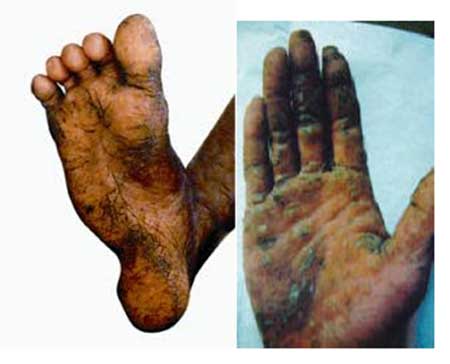
Pic of Arsenicosis : typical skin conditions leading upto cancers
Arsenicosis is a multi-system disorder, with virtually no system spared from its vicious claw; its predominant manifestations are linked to skin involvement, going upto skin cancers (Bowen’s disease, squamous cell carcinoma, and basal cell epithelioma) and other cancers. It also leads to Peripheral vascular disease (blackfoot disease), hypertension, ischemic heart disease, gastro-intestinal problems including liver diseases (non-cirrhotic portal hypertension, hepatomegaly etc), nervous diseases (peripheral neuropathy), respiratory and kidney involvement, bad obstetrical outcome, hematological disturbances, and diabetes mellitus are among the other clinical features linked to arsenic toxicity. Millions of people are victims of arsenicosis, particularly in Ganga-Brahmaputra basin . A typical skin condition is shown below.
More on Fluorosis
Dr. AK Susheela (ex-AIIMS Delhi) , an internationally renowned expert on fluorosis, for decades has been warning that the whole body metabolism is impaired in various forms, and literally hundreds of problems of health flow from this basically water-related disease. Then there are pregnancy and child-birth problems related to fluorosis, apart from impaired IQ in children, affecting whole generations to come. This is apart from the havoc played by fluoride-added, branded toothpastes, about which she raised her voice decades ago, but not heeded as 90 percent of them , flooding Indian market, are made by MNCs like Colgate.They print a subtle warning in small print to escape their responsibilty, a result of struggle led by people like Dr. AK Susheela. The Indian ruling classes have been servile to MNCs, despite claims of nationalism and Swadeshi, more so by BJP. And the rulers have been callous, because, as Dr. Raja Reddy (Ex-NIMS, Hyderabad), another expert who studied the problem for decades, said : It is after all a disease of the poor man, and aggravated by the endemic poverty.
Ensuring supply of safe, potable, preferably surface water is the only and real solution to it, he explained. But this basic task is left unattended by callous governments for decades. And Modi and NDA made no difference to the situation. Tragically, this water-related problem haunts crores of people living virtually by the side of perennial rivers like Ganga, Brahmaputra, Godavari and Krishna, not to speak of smaller rivers, because their waters are not mostly supplied to rural masses, who are forced to rely on untested or /and unsafe ground water . Only recently, a few places like Telangana realized the gravity of the problem, gave priority to drinking water, thanks to a mass movement for decades.
What sort of Make in India can we have with crippled people ?
Now fluorosis , caused by contaminated water in the main, is affecting crores of Indians, as governments failed to supply safe drinking water 70 years after independence. This is when India claims to be an emerging super power equipped with hitech gadgets to rocket and satellite technology. Thousands of people, mostly of toiling classes, across India are crippled by Skeletal fluorosis as the following picture from UP tellingly displays. What sort of Make in India can we create when we have toilers like this?
75 percent of all diseases in India are somehow related to drinking water.If the warning bells rung by fluorosis victims in Varanasi can alert the powers that be on this problem, the purpose would be served.
UP including Varanasi are worst affected by contaminated waters
Prime Minister Modi and BJP Chief Amit Shah have been campaigning, all over India, with half-truths, promising development for all, sab ka vikas, ‘as in BJP-ruled states’ ! UP Chief Minister Adityanath too is pressed into service in many places including Kerala and Tamilnadu in a bid to invoke rabid Hindutva. Their performance in those states, UP included, is too poor for comparison, as can be seen below.
Of course, none can accuse Modi of discrimination. Every district of Gujarat is a victim of fluorosis.That perhaps is part of the Gujarat model of development. But it is to be noted : Number of affected habitations in Gujarat is shown, in the Annexure to the Loksabha reply, as NIL, not as NA (not available);it was thus shown more than once. The fact is almost all districts (24 out of 25) of Gujarat are threatened by fluorosis. We do not know if it is a deliberate omission, yet another instance of post-truth?
Other states, BJP-ruled for long, top the list in fluorosis : Rajasthan, all of its 32 Dts, is badly affected by Fluorosis. MP 39 dts, 12 of Haryana…Such is the vikas. Congress-ruled, ‘developed state’ of Punjab has it in all of its 20dts.
Given below is a photo from UP, Sonbhadra zone, hardly 70 km from Varanasi; the women are NOT of old age, but crippled by polluted drinking water. Sonbhadra pointed to high levels of mercury and fluoride in the air and water . It speaks volumes of how the very basic problems like supply of safe drinking water are neglected, even as tall claims are made about India emerging into a super power, under the leadership of a kaamdar PM, and a ‘very popular’ sanyasi as CM of UP. And UP was ruled earlier for decades by Congress, and recently for several terms by SP and BSP.

Accursed Country : Upriver from Benares, ask Sonbhadra’s people about the price of development. It shows on their bodies, says a Report in OUTLOOK weekly magazine (10 November 2014). Sonbhadra pointed to high levels of mercury and fluoride in the air and water . (https://www.outlookindia.com/magazine/story/accursed-county/292455)The women are NOT of old age, but crippled by polluted drinking water.
An academic study by Nandimandalam Janardhana et al of JNU about this region states:
“Severe health disorders have been identified in parts of the Kachnarwa region, which is in the upper Panda river basin, Sonbhadra District, Uttar Pradesh, due to excess intake of fluoride through drinking water…. The concentration of fluoride in the groundwater of the study area varies from 0.483 to 6.7 mg/l. Among the 17 samples analysed, 8 exceeded the maximum permissible limits of fluoride in the study area. …The worst fluoride-affected villages are Rohini yadamar, Madhuri, Nerui yadamar, Gobardaha and Kunrwa. Most people in these villages suffer from dental and skeletal fluorosis such as mottling of teeth, deformation of ligaments, bending of spinal column and ageing problem. An urgent need is to educate the people on the causes of fluorosis, encouraging rain-water harvesting and providing fluoride-free drinking water in the study area. ”(CURRENT SCIENCE, VOL. 96, NO. 7, 10 APRIL 2009)
Anything above 0.5 mg is unsafe, and above 1mg is bad enough, as per the recommendations of an International Conference on Fluorosis held in Hyderabad, in November 2016, where FMRRC was also represented. In UP hundreds of habitations have it at 2 to 4 to 6mg.The two photos from Varanasi area published here, above and below, illustrate the gravity of the problem, but not felt by the govt.
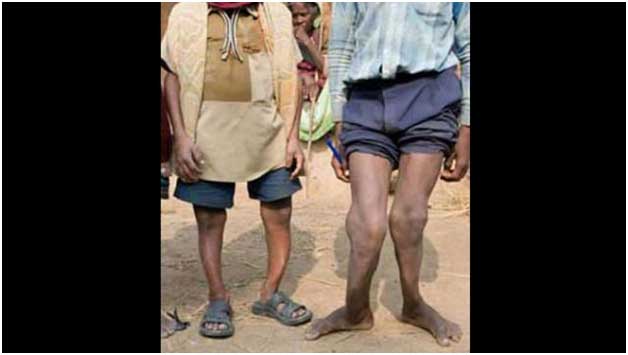
Danger of skeletal fluorosis : See legs affected. From around Varanasi. Source : Varanasi Hindi News – Hindustan
Apparently, no effective steps were taken since the above photo was taken five years ago, despite Modi and Adithyanath. The above discussion shows the grave situation and total neglect by ruling classes. Hence the significance of contest by many victims of fluorosis to focus on the problem.
Varanasi contests, reported below, are meant to tell the kaamdar PM of the failure of governments led by him and by his colleagues including Adithyanath.
thehindubusinessline.comon April 09, 2019 reported :
Twenty victims and activists from the fluorosis-hit States are going to file nominations on April 22.Thirty-four-year-old Anshula Swami, Suvarna Ramavath (24) and Veeramalla Rajitha (25), are down with fluorosis, like thousands of others in Nalgonda district of Telangana.After years of protests, they along with 18 others have decided to file nominations from Varanasi and Rae Bareli, from where Prime Minister Narendra Modi and Congress President Rahul Gandhi are going to contest, respectively.
“There’s no let up in the condition despite the change of governments. We demand a corporation for fluorosis victims, a pension of Rs. 5,000 to Rs 15,000, depending on the seriousness of the condition,” Kanchukatla Subhash, who leads Fluorosis Vimukti Porata Samithi, Nalgonda, told BusinessLine. The victims demand a national research centre to find the solution. “It was sanctioned about 10 years ago. We showed them 8.5 acres for the centre, which is supposed to have a 50-bed hospital as well,” Subhash said.
Rs 100 crore was promised years ago by the Centre for the research centre. Dr Arjun Khandare of National Institute of Nutrition,
Hyderabad, who had worked for years on fluorosis was to head it, as announced. Fluorosis experts and activists from across India , including Dr Sundar from Inrem Gujarat, and a team of FMRRC led by Dr Bapuji had visited, besides affected villages, the proposed site and Dr Khandare’s NIN office, years ago, and hoped things were falling in line.
But nothing came of it, despite a kaamdar PM. Rahul Gandhi , in a recent election speech in Telangana promised a huge and modern hospital for fluorosis victims, while the need was to ensure supply of safe drinking water to the entire population. While Telangana govt. Indeed took measures on this problem, AP led by CM Chandra Babu Naidu is not much bothered about it. The latter, an ally of BJP and NDA for long, promised a few dialysis centres for the affected areas, welcome to corporate interests, rather than solving drinking water problem.
It is not as if Opposition is making false allegations. Over 10 crore people in the country are getting water contaminated with excess fluoride, the Lok Sabha was informed on December 21, 2017, reported PTI. Minister for Drinking Water and Sanitation (MDWS) Narendra Singh Tomar said during Question Hour : About 10.06 crore population in different states and union territories are getting drinking water with excess fluoride, he said. The same statement mentions “about 28,000 arsenic and fluoride affected habitations”. (livemint.com, hindustantimes.com, newindianexpress.com, among others, published this news.)
This was one of the most stunning admissions by the government about the health status of the country in recent past. But it was not focussed by the big media, as it should have been: The polity, hence the big media, is lost amidst rapacious political forces working 24x7x365 to grab and retain power with no concern for the well-being of the people, more so the toiling masses. Amidst so many ‘welfare schemes’, and huge budgets, meant more to swindle funds than to deliver goods, the most serious problem of drinking water, of fluorosis, and of arsenicosis, continues to be neglected, despite the Indian State admitting its seriousness.
Obviously, arsenic- affected habitations are larger in numbers than fluoride -affected habitations. While excess Fluoride is a slow poison, Arsenic is a deadly poison spreading in most of the Gangetic-Brahmaputra-Meghna belt.More than one lakh villages are in this danger zone. See this Report : “ In 6 states of the Ganga-Brahmaputra Plain, 704 lakh people are potentially at risk from groundwater arsenic toxicity.”
(sciencedirect.com/science/article/pii/S0946672X16300712)
Apart from UP, Bengal Bihar and Assam, all most populous states, are in the midst of this danger zone. Maharashtra and Gujarat, said to be in the fore-front of development, are also among the worst-affected, not to speak of states like Rajasthan. Do we notice any discussion of this problem in the election speeches of Modi, Amit Shaw, Rahul, Nikhilesh, Akhilesh, Sharad Pawar, Fadnavis or Mamata or Mayavati ?
Tall claims of Vikas Vs Poor Record, as per CAG
More than 163 million Indians–more than the population of Russia–do not have access to safe drinking water, and the national rural drinking water programme, despite spending 90% of Rs 89,956 crore over five years to 2017, has “failed” in its targets, according to an August 2018 report from the government’s auditor, CAG.
See this extract from an analysis of the CAG report by Shreehari Paliath, dated November 26, 2018, in indiaspend.com :
“ The programme’s target: Providing 35% of rural households with water connections and 40 lt–about two buckets–of water per person per day. Less than half that target was achieved, thanks to “poor execution” and “weak contract management”, said the audit report from the Comptroller and Auditor General (CAG).
“About 78% of 1.7 million rural Indian habitations have accessto the minimum required quantity of water, 40 lt–roughly two buckets of water–per person per day, but that does not mean they actually get this water, experts said. “ NRDWP is a centrally sponsored scheme aimed at providing every person in rural India with “adequate, safe water” for drinking, cooking and other domestic basic needs in a “sustainable manner”, according to the ministry of drinking water and sanitation website. The scheme provides financial and technical assistance to state governments to install rural drinking water connections.
“ One of the goals of the Ministry of Drinking Water and Sanitation’s 2011-2022 strategic plan was that every rural Indian would have access to 70 lpcd within his or her household premises or at a horizontal or vertical distance of not more than 50 m.
“As of December 2017, only 44% of rural habitations and 85% of government schools and anganwadis could be provided access to safe drinking water, only 18% of rural population were provided potable drinking water by piped water supply and only 17% of rural households were provided household connections,” said the CAG report.
“ The proportion of rural habitations with safe drinking water increased by no more than 8% at 40 lpcd and 5.5% at 55 lpcd after spending Rs 81,168 crore during the period 2012-17; 90% of Rs 89,956 crore (central share of Rs 43,691 crore and state share of Rs 46,265 crore) provided for the programme was spent over this period, the CAG report said. The highest expenditure (84%) was in 2014-15.”
The highest expenditure (84%) in 2014-15 is presumably related to an election year. It is presumably a hang-over of the previous UPA Govt. that lasted upto summer 2014. Evidently, election times see such surge in spending, and that helps election funds of ruling parties, by huge pilferages. And note that later years saw only 16 percent spending, ie., under NDA, which led by kaamdar PM, obviously spent very little after the elections were over, and failed to meet the targets. Huge corruption and mismanagement can be visualized by the fairly huge expenditure within a short range of time.
335 districts in 20 major states affected, but Neglected By All Political Parties for decades
Though the present contest is mainly in Varanasi, and also tokenly in Rae Bareily, the problem is related to entire country. See the following estimates indicating aggravation of the problem over the years despite claims of development :
–1974: 25-30 million (2.5 to 3.0 crore) people at risk and half a million (5lakh) were reported crippled.
–1999 (UNICEF): 201 districts affected and 60 million at risk. 6 million people crippled.
–2009(Ministry of health and family welfare): 275 districts are affected and 66 million people are at risk in endemic areas. 6 millions are crippled.
–2017 (Ministry of Water Resources) : Fluorosis in 335 dts, 10 crore people threatened. Arsenic 153 dts.; 7 crore people by Arsenic in water.
Rural drinking water programs have existed in various forms since 1972- 73, starting with the Accelerated Rural Water Supply Programme, followed by a Technology Mission in 1986. Subsequently, the Sector Reform Project was initiated in 1999-2000, with an aim to involve the rural community in planning, implementation and management of drinking water schemes. From 2009, it has been renamed as theNational Rural Drinking Water Programme.
Estimates cited above from 1974 to now show that the situation got aggravated even as programs and plans existed, obviously ineffectively. The last five years of Modi regime,despite tall claims, failed to rise to the occasion.
Thus the question that arises : Swatcha Bharat – is it possible without Swatcha (pure and safe) water? In a country that has a defence Budget of around Rs. 4 lakh crore (2018-19), this issue is totally neglected, as can be seen clearly.
River waters : Priority for drinking water
It is sad to note that this menace of polluted waters, including fluoride-ridden ground waters, plagues many regions in India right adjacent to rivers like Ganga, Brahmaputra, Godavari, Krishna, Malaprabha, Tungabhadra, Bhima. River waters are safer, mostly free from fluoride and the like pollutants. Big irrigation projects, with huge public investments, have been there basically to benefit the landed gentry. But they are not used to solve the drinking water needs of the rural poor, most of them landless and land-poor, who anyhow get no benefit of such projects. Their plight is only to face problems of displacement for the sake of these projects, often with no proper, adequate and timely relief and rehabilitation despite many awards and verdicts by the top judicial and official bodies in their favor. Surface waters, ie., rivers, lakes, rain-waters, are mostly free from fluorosis and conserving them is the real and lasting solution.
As surface waters are neglected for decades, and denied for drinking purposes, people are forced to compete for most basic need of drinking water : See photo, given below, from Maharashtra, a most advanced state, with the commercial capital of India.
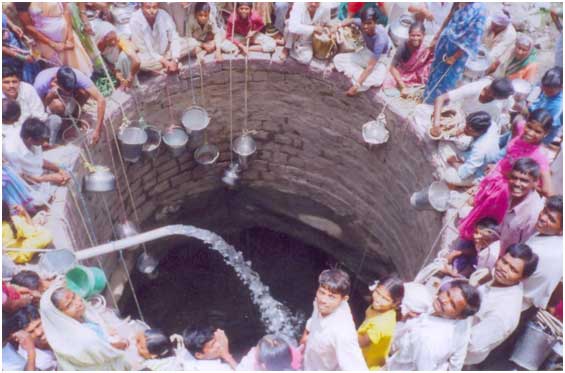
Those who have lived through the severe drought in 1972 which gave birth to Maharashtra’s landmark employment guarantee scheme (EGS), remember there was a shortfall of foodgrains, not water. This time it is water that is absent in most places in the Marathwada region of Maharashtra and very little provision for fodder and no work under the EGS either.
No big hospitals are needed, nor will help, to address the problem of Fluorosis, including its dangerous form of skeletal fluorosis. Mere supply of safe drinking water, along with tackling malnutrition , will help solve the problem as shown in the photo below.
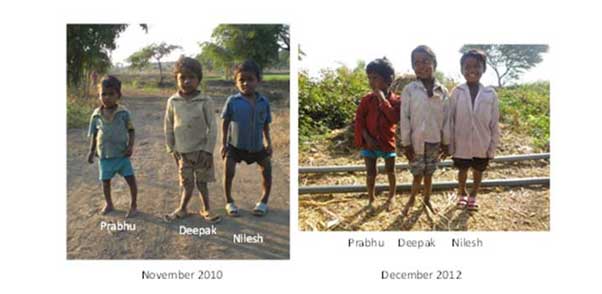
Photo : Fluorosis affected children in Madhya Pradesh. (Notice the bent legs). Same children after 2 years of ‘treatment’ (Notice straight legs).(Courtesy : Inrem, Gujarat)
People’s movement in Telangana
Thanks to a prolonged and massive people’s movement in Telangana, more so in Nalgonda dt., drinking water had become a burning political issue. There was some response. In 2013-14, the then Congress government of AP, to avert division of the state, paid attention to it and laid drinking water pipelines for some of the affected villages to supply Krishna river water. It also set up RO plants (reverse osmosis) plants in villages to treat ground water, but it did not provide a permanent solution. But it was too little, too late.
The new Telangana State (TS) government, post-bifurcation of AP in 2014, made certain tangible commitments on the fluorosis question in particular, on drinking water in general. Its Mission Bhagiratha is a project for safe drinking water for every village and city household in Telangana State, with a budget of Rs. 43,791 crores. The project aims is to provide piped water to 2.32 crore people in 20 lakh households in urban and 60 lakhs in rural areas of Telangana. The ambitious project will supply clean drinking water to all households in the state through water sourced from River Godavari (22 TMC) and River Krishna (19 TMC). TRS led by KCR, responding to a mass movement in Telangana, had promised before 2014 elections that it would accord top priority to fluorosis and safe drinking water , devise suitable plans to supply safe drinking water to every door-step by 2019 and added it would not seek votes again if it did not fulfill that promise in a time-bound manner. The works were to be completed by December 2018. Hectic work has been going on to fulfill that promise.
The problem, however, does not end with provision of drinking water. The villagers consume rice, vegetables and fruits grown on water polluted with fluorine and the government’s next plan is to provide canal irrigation from rivers, and to improve ground water table, by repairing all tanks and lakes. It was a good beginning.Drinking water supply would be top priority followed by irrigation, and industrial needs and power generation, said the Chief Minister who asserted that at least 10 per cent water should be reserved for drinking water needs. Orders were issued accordingly.
All other solutions, like filtered water projects, are inherently flawed, merely temporary, not sustainable, and too costly. People across India need to act on these slogans. They need to learn from Telangana people. FMRRC has been in touch with groups across India like Inrem, Gujarat, besides those in Assam, Odisha, Kerala etc. It has been in touch with FAN, Fluoride Action Network and Fluoridealert.org, operating from USA. It is a gigantic problem facing India, more so its toiling masses. It calls for sustained efforts on the part of one and all.
Based on various experiences and field studies, drawn from Karnataka, Telangana and Andhra Pradesh, and with its humble efforts, FMRRC, had suggested a program of SEAM, ie., sensitize, educate, agitate, mobilize, on drinking water. It has called for a movement for drinking water as a Fundamental Right.
It is to be hoped that the present mass contest in Varanasi by fluorosis victims in elections to the Loksabha will help to focus on the grave problem and instill a sense of urgency.
( FMRRC, Fluorosis Mitigation Research and Resource Centre, based in Hubli, Karnataka, is a small group with Dr. KS Sharma as its Founder- Chairman, and Dr. M. Bapuji, Senior Scientist Ex-CSIR as its Scientific Advisor . It is not an NGO, but is part of a larger mass movement of workers (IRTUC) and rural poor ( Krantikari Janandolana) of Karnataka. For more Info, email to kuvalaya_hubli@rediffmail.com and to bapujim@gmail.com)
Courtesy: Counter Current
